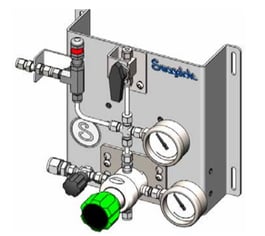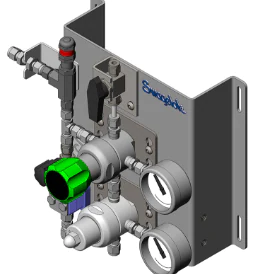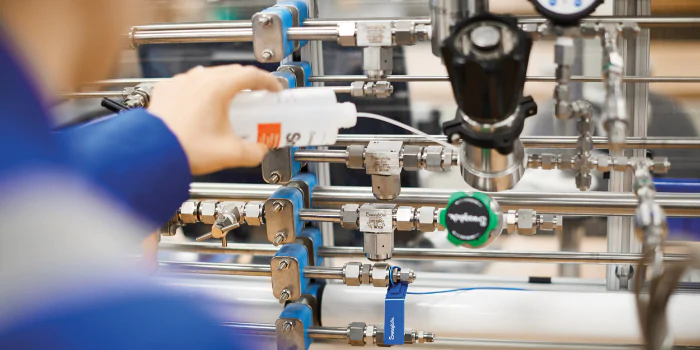A gas control panel is one of the four basic subsystems in a gas distribution system. Although you can rightly claim that every subsystem is critical to the proper functioning of a gas distribution system, the gas control panel, as the first stage in managing high-pressure gas, deserves special design consideration.
The Purpose of the Gas Control Panel
The gas control panel is the primary pressure control point in a gas distribution system. It’s located in close proximity to the gas/fluid source (one or more cylinders or bottle) and reduces gas pressure from the cylinder(s) to deliver it at the correct pressure and flow rate to the point of use such as a laboratory, process equipment, or analyzer. A properly functioning gas distribution system requires a correctly-sized and selected pressure regulator. The primary gas control uses two methods for reducing the pressure—a single-stage pressure regulator or a dual-stage pressure regulator.
Two critical factors influence the control of gas pressure—droop and supply pressure effect.
Droop indicates the difference in delivery pressure between zero flow conditions and a regulator’s maximum flow capacity. The supply pressure effect indicates the changing delivery pressure as the supply pressure decreases as a cylinder empties. Single-stage and dual-stage regulators differ in their droop characteristics and response to changing supply pressure.
Single-Stage Pressure Regulator
 A single-stage pressure regulator reduces cylinder gas pressure within a specific range in one step. A single-stage regulator shows minimum droop as flow rates vary, but demonstrates a relatively large supply pressure effect. A single-stage regulator is typically used in applications where there’s little inlet pressure variation, constant outlet pressure is not critical, or periodic readjustment of delivery pressure does not present a problem.
A single-stage pressure regulator reduces cylinder gas pressure within a specific range in one step. A single-stage regulator shows minimum droop as flow rates vary, but demonstrates a relatively large supply pressure effect. A single-stage regulator is typically used in applications where there’s little inlet pressure variation, constant outlet pressure is not critical, or periodic readjustment of delivery pressure does not present a problem.
Dual-Stage Pressure Regulator
 A dual-stage gas pressure regulator reduces cylinder gas pressure in two steps. A two-stage regulator shows a considerable droop, but minimum supply pressure effects. A two-stage regulator provides constant delivery pressure without the need for periodic readjustment. Dual-stage regulators are used in applications that require constant outlet pressure throughout the life of a gas cylinder.
A dual-stage gas pressure regulator reduces cylinder gas pressure in two steps. A two-stage regulator shows a considerable droop, but minimum supply pressure effects. A two-stage regulator provides constant delivery pressure without the need for periodic readjustment. Dual-stage regulators are used in applications that require constant outlet pressure throughout the life of a gas cylinder.
Gas Panel Design Variations
Good panel design makes for easy installation and serviceability. Panel design begins with a standard backplate sized to match the width of standard gas cylinders. A standard size allows multiple panels to be installed without staggering the spacing. With a standard backplate, each panel can easily be configured for the specific requirements of the gas distribution system.
Optional components that may be incorporated into the design include vent and relief components for safe operations, upstream and downstream gas pressure indicators, and color-coded regulators and valves for easy identification. With a standardized backplate, all components on the panel can easily be detached for maintenance or upgrade, if needed.
Gas Panel Design Considerations
Not every company has the luxury of its own gas distribution system engineering staff. The majority lack in-house engineering resources and rely on the expertise and experience of local vendors. While the function of a gas control panel may seem relatively simple, a thorough understanding of the purpose of the gas distribution system and the planned or existing infrastructure is required to properly design the gas panel.
Type(s) of gas(es), the end-use application(s), and available component options influence the design of each gas panel. An experienced fluid systems engineer will consider all these factors to calculate the proper gas pressure and flow rate and determine the optimum gas control panel design.
Calculate Correct Gas Pressure and Flow Rate
There’s a wide range of common gases used in industrial applications—nitrogen, oxygen, carbon dioxide, argon, propane, propylene, hydrogen, helium, and acetylene. The semiconductor industry uses dozens of less common gases, such as bromine, phosphorus trifluoride, and titanium tetrachloride. To support an effective, consistent application, these gases must be reliably delivered at constant pressure and flow rates.
Calculating the correct delivery pressure and flow rate can be difficult. Here’s where the expertise of an experienced fluid systems engineer is vital in calculating the required pressure and flow rate based on the gas type and application. These calculations determine the pressure regulator sizing used on the gas control panel, and whether or not a single-stage or dual-stage pressure regulator is required. In many instances, calculations prove that a single-stage regulator will suffice, thereby reducing the cost of the panel and simplifying long-term maintenance.
Ensure Safe Operation
Safe operation is a requirement of any gas distribution system. Components chosen for the gas control panel must be rated to meet the pressure and temperature requirements of the process. Pressure control components such as relief valves and pressure regulators must be sized to manage the full range of potential gas pressures and flows to ensure safe system operations.
Operational differences between components are also a consideration. For example, a multi-turn needle valve and a ¼-turn ball valve may have the same ratings, though each valve is best suited for specific purposes. A multi-turn needle valve allows small increments of pressure. A ball valve can quickly change pressure and lead to a pressure spike. An experienced fluid systems engineer will specify the valve that facilitates the safest operation.
Certain gases may be harmful to the environment and/or employees working anywhere near the gas distribution system in the event of leakage. The risk of leakage can be reduced with the use of compression fittings in place of threaded fittings. Industry and local regulations may determine where and when the different fittings are acceptable and ensure the gas control panel is designed to comply.
Catastrophic leaks or breaks in a well-designed gas distribution system are rare. But in the event of a significant downstream leak, a restricted flow orifice strategically located close to the gas source limits the leak and provides an added level of protection for employees and the environment.
Accommodate Eventual Process Changes
Process conditions are likely to change, and savvy fluid system engineers should design the gas control panel to anticipate those changes. Sizing pressure controls to accommodate a wide range of pressure and flow parameters gives the system flexibility in meeting future processing requirements without the need to modify components on the gas control panel. Here too, design experience is critical. Specifying gas panel components for too broad a range of parameters can jeopardize the panel’s ability to deliver the required pressure and flow for the initially specified process.
Swagelok’s Experience in Gas Distribution System Design
Properly designed gas control panels are critical for the safe distribution of high-pressure gas to end-process applications at the required pressures and flow rates. Organizations with limited or no experience in designing gas distribution systems greatly benefit from the services provided by Swagelok. Our Field Services Engineers will conduct an in-depth assessment of your gas distribution requirements and use the results of the analysis to design a gas control panel for your specific needs. In addition to gas panels, we’re equally adept at designing and fabricating all of the other relevant subsystems to provide a complete gas distribution system.
We’ve been supporting the fluid processing needs of industries in Northern California for more than fifty years, and during that time we’ve established design practices that deliver gas distribution systems that are intuitive and safe to operate, easy to service, and minimize the potential for leaks. Swagelok gas panels are highly configurable, with features or modifications based on process requirements. Swagelok gas delivery panels come fully assembled and tested, and all gas distribution systems are backed by our Limited Lifetime Warranty.
To learn how Swagelok Northern California designs and fabricates gas distribution systems that are optimized for your specific applications to reliability and safely deliver gas at the required pressures and flow rates, contact our team today by calling 510-933-6200.



 A single-stage pressure regulator reduces cylinder gas pressure within a specific range in one step. A single-stage regulator shows minimum droop as flow rates vary, but demonstrates a relatively large supply pressure effect. A single-stage regulator is typically used in applications where there’s little inlet pressure variation, constant outlet pressure is not critical, or periodic readjustment of delivery pressure does not present a problem.
A single-stage pressure regulator reduces cylinder gas pressure within a specific range in one step. A single-stage regulator shows minimum droop as flow rates vary, but demonstrates a relatively large supply pressure effect. A single-stage regulator is typically used in applications where there’s little inlet pressure variation, constant outlet pressure is not critical, or periodic readjustment of delivery pressure does not present a problem. A dual-stage gas pressure regulator reduces cylinder gas pressure in two steps. A two-stage regulator shows a considerable droop, but minimum supply pressure effects. A two-stage regulator provides constant delivery pressure without the need for periodic readjustment. Dual-stage regulators are used in applications that require constant outlet pressure throughout the life of a gas cylinder.
A dual-stage gas pressure regulator reduces cylinder gas pressure in two steps. A two-stage regulator shows a considerable droop, but minimum supply pressure effects. A two-stage regulator provides constant delivery pressure without the need for periodic readjustment. Dual-stage regulators are used in applications that require constant outlet pressure throughout the life of a gas cylinder. 